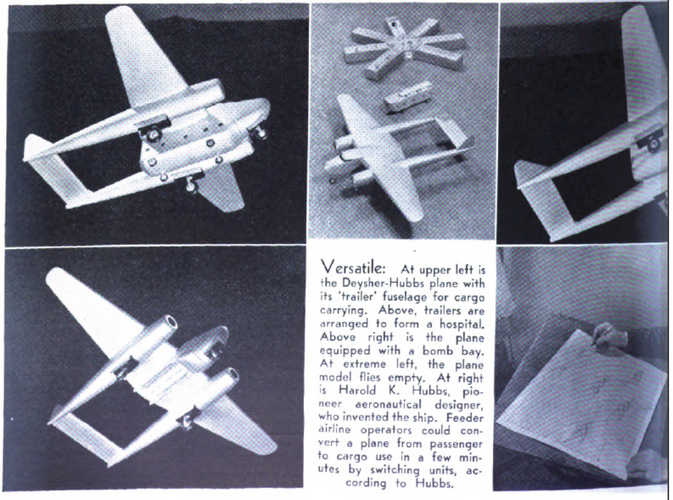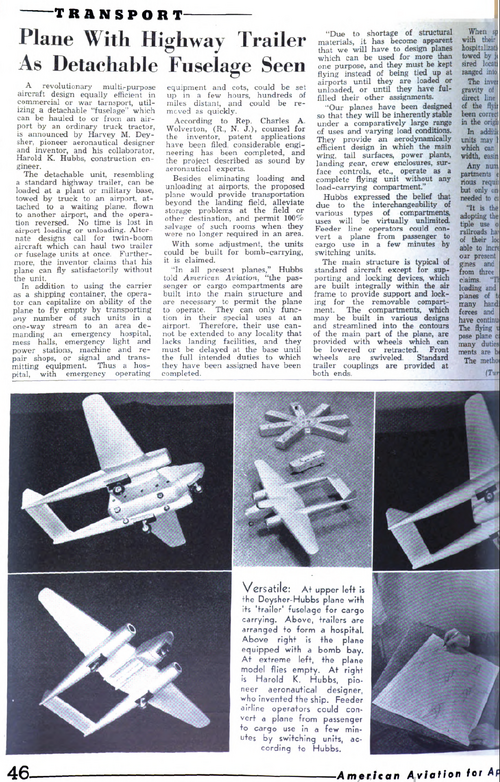You are using an out of date browser. It may not display this or other websites correctly.
You should upgrade or use an alternative browser.
You should upgrade or use an alternative browser.
Deysher-Hubbs Twin-Boom Detachable Fuselage Transport of 1942
- Thread starter hesham
- Start date
Tonton-42
ACCESS: Secret
- Joined
- 10 May 2014
- Messages
- 311
- Reaction score
- 556
From time to time the detachable container principle appears. Although it may be avant-garde in appearance and very attractive on paper, it is clear that this formula has not been successful in a century ... Is that a shame ?
1635yankee
Recovering aeronautical engineer
- Joined
- 18 August 2020
- Messages
- 478
- Reaction score
- 608
In response to Tonton, I suspect the reasons around the failure of detachable pods for cluster around the facts that human transport, not cargo, and the nature of thcargo that can walk itself into the plane and even secure itself in place. Another factor is that air cargoes are small, so loading and unloading even a 747 or A380 freighter is relatively fast.
It may be a cool idea, but the economics don't work.
It may be a cool idea, but the economics don't work.
1635yankee
Recovering aeronautical engineer
- Joined
- 18 August 2020
- Messages
- 478
- Reaction score
- 608
To add to that: outside of the military, the commercial aviation sector is driven by the carriage of passengers, not cargo, and the types of military cargoes don't seem well-served by the removable fuselage concept. For that to work, there needs to be spare fuselages hanging around. The only reason for a removable fuselage would be to reduce turnaround for cargoes. Given that even a C-5 stuffed with palletized cargo can probably be emptied in a few hours, there doesn't seem much room for time savings.In response to Tonton, I suspect the reasons around the failure of detachable pods for cluster around the facts that human transport, not cargo, and the nature of thcargo that can walk itself into the plane and even secure itself in place. Another factor is that air cargoes are small, so loading and unloading even a 747 or A380 freighter is relatively fast.
It may be a cool idea, but the economics don't work.
I believe, the only real advantage could have been, that such an aircraft could become a real multi purpose aircraft. It could serve functions like passanger and cargo transport but also be used as fire fighter, ambulance, tanker or reconaissance plane. This might have been usefull for millitary bases in remote areas with limited recources for different aircraft types. Of course there would have been different attached modules for those purposes.
Last edited:
- Joined
- 11 March 2012
- Messages
- 3,124
- Reaction score
- 2,964
I suspect that the biggest limitation is the cost and weight of cargo containers. Light-weight containers are expensive and short-lived.
If ISO 20 or ISO 40 shipping containers were light enough to go by air, then the system would be profitable.
Consider how the only significant produciton version of this concept was Sikorsky's CH-64 Skycrane. They only sold a few during the Vietnam War and all subsequent production has been the enclosed CH-53 Stallion based on the same rotor system.
Erickson eventually bought the type certificate and now makes a few new Skycranes that are primarily used to drop water on forest fires. During the off season they work as flying cranes.
If ISO 20 or ISO 40 shipping containers were light enough to go by air, then the system would be profitable.
Consider how the only significant produciton version of this concept was Sikorsky's CH-64 Skycrane. They only sold a few during the Vietnam War and all subsequent production has been the enclosed CH-53 Stallion based on the same rotor system.
Erickson eventually bought the type certificate and now makes a few new Skycranes that are primarily used to drop water on forest fires. During the off season they work as flying cranes.
I have to admit, I just read the text the first time (couldn't read it on my mobile....) and indeed, it is about versatility and not so much about cheaper cargo transport. In this regards, it is a quite promising approach, probably the certifications killed it, if every possible module has to be certified separately.
Tonton-42
ACCESS: Secret
- Joined
- 10 May 2014
- Messages
- 311
- Reaction score
- 556
A forum about over the same subjet by Fieseler : https://www.secretprojects.co.uk/threads/fieseler-projects.36042/
Similar threads
-
Flightglobal suggested a twin boom torpedo bomber
- Started by hesham
- Replies: 4
-
Airspeed Transport Projects from 1942
- Started by Schneiderman
- Replies: 15
-
-
Early Army Air Service tests of Martin Bomber carrying SE-5 detachable fuselage and parachute
- Started by Stargazer
- Replies: 2
-
PCA Twin-Boom Detachable Fuselage Cargo Aircraft of 1945
- Started by hesham
- Replies: 4


